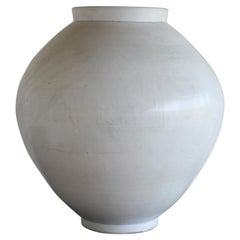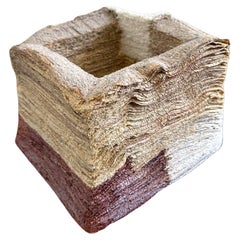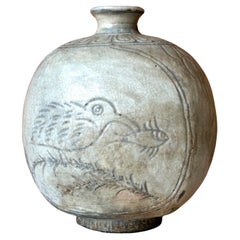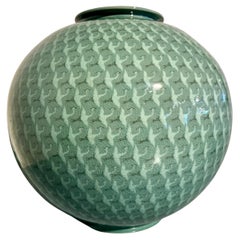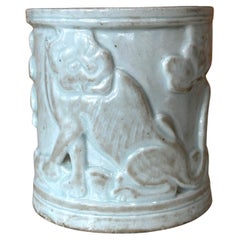Korean Ceramics
89
4
to
1
87
93
93
93
2
1
55
29
5
4
3
1
93
12
8
5
3
920
4,378
3,814
2,049
1,662
1
1
Place of Origin: Korean
White Porcelain Moon Jar, Joseon Dynasty / 1392-1897
Located in Kyoto-shi, Kyoto
This is a white porcelain jar from the mid-Joseon period, also known as a "Talhunari" or "moon jar". During the Joseon Dynasty, which was strongly influenced by Confucianism, the purity of white porcelain was particularly prized in its artistic expression due to its Confucian sensitivity. The defining characteristic of white porcelain during this period was its pure white color, but there were many subtle variations in the white hues, with some being classified as milky white, snowy white, ashen white, and bluish white.
The term "Talhunari" means "moon jar" in Korean, and it refers to the large, round shape of the jar, resembling a full moon. It was named by Kim Whanki, a representative abstract painter of Korea. The soft, curving lines and sturdy body that seems to embrace the full moon give the jar both power and tranquility. This type of jar was produced in large quantities during the 17th century.
The white of the moon jar is not the pure white of early Joseon porcelain...
Category
18th Century Antique Korean Ceramics
Materials
Ceramic, Porcelain
Ceramic Sculpture by South Korean Artist Jongiin Park
By Jongjin Park
Located in Atlanta, GA
A highly unique ceramic sculpture by South Korean artist Jongjin Park (1982-). The square-form piece is boundary-pushing and defies both the traditional function of a vessel and the ...
Category
2010s Organic Modern Korean Ceramics
Materials
Ceramic, Paper
Antique Korean Buncheong Flat Bottle Vase with Incised Designs
Located in Atlanta, GA
A Korean Buncheong stoneware vase circa 15th century of Joseon Dynasty. The robust vase with thick walls was made in a bottle form with rounded square contour and flattened surfaces....
Category
15th Century and Earlier Archaistic Antique Korean Ceramics
Materials
Ceramic
Massive Modern Korean Celadon "Thousand Cranes" Moon Jar, 21st Century, Korea
Located in Austin, TX
A large and impressive modern Korean slip inlaid celadon "Thousand Cranes" moon jar attributed to Han Gi Woong, 21st century, South Korea.
The moon jar is decorated all around with ...
Category
2010s Korean Ceramics
Materials
Porcelain
Korean Buncheong Joseon Dynasty Antique Glazed Pottery Ceramic Wabi-Sabi Vase
Located in Studio City, CA
A beautifully and sumptuously blue and white crackle glazed and colored, moon pot shaped, hand-decorated/painted Korean Buncheong porcelain vase. Joseon Dynasty (1392-1910). The vase...
Category
19th Century Antique Korean Ceramics
Materials
Porcelain, Pottery
Korean White Ceramic Brush Holder Joseon Dynasty
Located in Atlanta, GA
A lovely Korean white porcelain brush holder with carved relief design from late Joseon dynasty (circa 19th century). The brushpot is highlighted with one of the most beloved motifs ...
Category
19th Century Other Antique Korean Ceramics
Materials
Ceramic
Korean White Ceramic Brush Holder Joseon Dynasty
Located in Atlanta, GA
An antique Korean white porcelain brush holder in floral pattern with cutout design from late Joseon dynasty circa 19th century. Cherished by the scholars, this brushpot would grace ...
Category
19th Century Other Antique Korean Ceramics
Materials
Ceramic
Rare Korean Water Dropper in Doughnut Form Joseon Dynasty
Located in Atlanta, GA
A Korean blue and white porcelain water dropper in a rare hallowed out doughnut shape from Joseon Dynasty circa 1800s. The octagonal water dropper is covered in a brilliant white gla...
Category
Late 18th Century Other Antique Korean Ceramics
Materials
Ceramic
Korean Ceramic Faceted Blue and White Bottle Vase Joseon Dynasty
Located in Atlanta, GA
A Korean blue and white long neck vase in bottle form with octagonal faceted surface from Joseon Dynasty (19th century). The elegant vase is covered in a white glaze with a tint of c...
Category
19th Century Archaistic Antique Korean Ceramics
Materials
Ceramic
Pair of Small Korean Celadon Inlay Vases Goryeo Dynasty
Located in Atlanta, GA
On offer is a near pair antique Korean ceramic vase from the end of Goryeo to the beginning of Joseon period (circa 14-15th). The vases feature cel...
Category
15th Century and Earlier Archaistic Antique Korean Ceramics
Materials
Ceramic
Antique Korean Porcelain Peony Jar Joseon Dynasty
Located in Atlanta, GA
A Korean white porcelain jar with underglaze blue painting of large peonies with leaves circa second half of 19th century, Joseon Dynasty. Considered associated with Punwon-ri kilns ...
Category
Late 19th Century Other Antique Korean Ceramics
Materials
Porcelain
Fine Korean Porcelain Jar with Chrysanthemum Design Joseon Dynasty
Located in Atlanta, GA
A fine Korean white porcelain jar with underglaze blue painting circa second half of 19th century, Joseon Dynasty. Considered associated with Punwon-ri kilns in Gwangju, these types ...
Category
Late 19th Century Other Antique Korean Ceramics
Materials
Porcelain
Antique Korean Porcelain Peony Jar Joseon Dynasty
Located in Atlanta, GA
A Korean white porcelain jar with underglaze blue painting of large peonies with leaves circa second half of 19th century, Joseon Dynasty. Considered associated with Punwon-ri kilns ...
Category
Late 19th Century Other Antique Korean Ceramics
Materials
Porcelain
Korean Pottery Funerary Urn Unified Silla
Located in Atlanta, GA
A terracotta pottery funerary urn with lid from Korea Unified Silla Period, circa 9th century. The jar was in a classic globular form with raised shoulder. Although the surface was u...
Category
15th Century and Earlier Other Antique Korean Ceramics
Materials
Ceramic
Korean ceramic storage jar
Located in Point Richmond, CA
Korean ceramic storage jar, thickly potted with slanted shoulder decorated in under glaze cobalt blue of blossoming sprays, simple rolled lip and footed base, glazed overall in a tra...
Category
Late 19th Century Other Antique Korean Ceramics
Materials
Ceramic
Antique Korean Blue & White Bottle Vase
Located in Point Richmond, CA
Korean ceramic bottle vase, squat globular form with tall narrow neck and cup shaped mouth rim, short foot glazed overall in a crackled translucent glaze with kiln grit adhering to t...
Category
19th Century Other Antique Korean Ceramics
Materials
Ceramic
Korean Celadon Jar with Four Handles. Goryeo dynasty, 12th century.
Located in Point Richmond, CA
Korean Celadon Jar with Four Handles. Goryeo dynasty, 12th century.
A stoneware body of baluster form with bulbous high shoulder, four small strap ...
Category
15th Century and Earlier Other Antique Korean Ceramics
Materials
Ceramic, Celadon
Korean Glazed Ceramic Vase Buncheong Ware Joseon Dynasty
Located in Atlanta, GA
A small antique Korean Buncheong stoneware vase from early Joseon Dynasty circa 16th century. The vase is of a classic pear form with a waisted neck, a flared mouth and a ringed base...
Category
16th Century Other Antique Korean Ceramics
Materials
Ceramic
Rare Korean Ceramic Brush Holder Joseon Dynasty
Located in Atlanta, GA
A rare Korean porcelain brush holder in Banana Leaves pattern from late Joseon dynasty circa 19th century. Cherished by the scholars, this brush...
Category
19th Century Other Antique Korean Ceramics
Materials
Ceramic
Moon Jar 'Dalhanari', Lot3 / 17th Century / Korean Antiques / Joseon Dynasty
Located in Kyoto-shi, Kyoto
This is a white porcelain jar from the mid-Joseon period, also known as a "Talhunari" or "moon jar". During the Joseon Dynasty, which was strongly influenced by Confucianism, the purity of white porcelain was particularly prized in its artistic expression due to its Confucian sensitivity. The defining characteristic of white porcelain during this period was its pure white color, but there were many subtle variations in the white hues, with some being classified as milky white, snowy white, ashen white, and bluish white.
The term "Talhunari" means "moon jar" in Korean, and it refers to the large, round shape of the jar, resembling a full moon. It was named by Kim Whanki, a representative abstract painter of Korea. The soft, curving lines and sturdy body that seems to embrace the full moon give the jar both power and tranquility. This type of jar was produced in large quantities during the 17th century.
The white of the moon jar is not the pure white of early Joseon porcelain...
Category
17th Century Antique Korean Ceramics
Materials
Ceramic, Porcelain
Korean Ceramic Ido Tea Bowl Chawan Joseon Dynasty
Located in Atlanta, GA
A ceramic stoneware chawan tea bowl made in Korea circa 16-17th century. The chawan is identified as Ko-ido (small ido) due to its size and form. Ido bowls were made since 15th centu...
Category
17th Century Other Antique Korean Ceramics
Materials
Ceramic
Korean White Glazed Porcelain Bottle Vase, Joseon Dynasty, 18th Century
Located in Austin, TX
A quiet and elegant Korean white glazed bottle vase, Joseon Dynasty, late 18th century, Korea.
The graceful vase beautifully proportioned, resting on a short recessed foot, with a...
Category
Late 18th Century Antique Korean Ceramics
Materials
Porcelain
Moon Jar 'Dalhanari' - Lot2 / 17th Century / Korean Antiques / Joseon Dynasty
Located in Kyoto-shi, Kyoto
This is a white porcelain jar from the mid-Joseon period, also known as a "Talhunari" or "moon jar". During the Joseon Dynasty, which was strongly influenced by Confucianism, the purity of white porcelain was particularly prized in its artistic expression due to its Confucian sensitivity. The defining characteristic of white porcelain during this period was its pure white color, but there were many subtle variations in the white hues, with some being classified as milky white, snowy white, ashen white, and bluish white.
The term "Talhunari" means "moon jar" in Korean, and it refers to the large, round shape of the jar, resembling a full moon. It was named by Kim Whanki, a representative abstract painter of Korea. The soft, curving lines and sturdy body that seems to embrace the full moon give the jar both power and tranquility. This type of jar was produced in large quantities during the 17th century.
The white of the moon jar is not the pure white of early Joseon porcelain...
Category
17th Century Antique Korean Ceramics
Materials
Ceramic, Porcelain
Kundika Bottle Celadon with Incised Flower / 12th Century / Korean Antique
Located in Kyoto-shi, Kyoto
A "Johin" is a vase used to hold pure and clean water. According to the ancient Buddhist scripture "Lotus Sutra," it was originally one of the 18 tools that Buddhist monks were required to possess, but later came to be used as a vessel for offering clean water to the Buddha. During Korea's Goryeo period, it was also commonly used as a water storage container.
The vase is adorned with delicate floral patterns engraved with fine lines on its front and back. Among other Goryeo celadon...
Category
15th Century and Earlier Antique Korean Ceramics
Materials
Ceramic, Celadon
Set of Ki-Seto Ceramic Altar Pieces from Korean Empire Period
Located in Atlanta, GA
A set of three ki-seto (yellow-seto) ceramic altar pieces made in the period of Korean Empire (1897-1910), a short independent period after Joseon dynasty before the invasion and occupation by Japan. The set consists of a candle holder with a metal pricket, an incense burner with lid and a vase. Traditionally, there were used during ritual ceremony as the accoutrement for a small altar table...
Category
Early 20th Century Other Korean Ceramics
Materials
Ceramic
Antique Korean Ceramic White Bowl Joseon Dynasty
Located in Atlanta, GA
A Korean ceramic rice bowl covered in a white glaze with a hint of bluish green color circa 19th century toward the end of Joseon Dynasty. The deep bowl...
Category
19th Century Other Antique Korean Ceramics
Materials
Ceramic
Moon Jar / Korean Antique vase / Joseon Dynasty / 18th Century
Located in Kyoto-shi, Kyoto
It's a wonderful moon jar. It is a rare size that is suitable for the alcove of a Japanese tea room. It is shaped at once without connecting the uppe...
Category
18th Century Antique Korean Ceramics
Materials
Ceramic
Korean Goryeo Celadon Glazed Slip Inlaid Bottle Vase, 12th/13th Century, Korea
Located in Austin, TX
A delightful small Korean Goryeo ware celadon glazed stoneware bottle vase with sangam slip inlay, Goryeo Dynasty, 12th - 13th century, Korea.
The sma...
Category
15th Century and Earlier Antique Korean Ceramics
Materials
Stoneware
White Porcelain Incense Burner / Korean Antique / Joseon Dynasty/1392 - 1897 CE
Located in Kyoto-shi, Kyoto
This incense burner presents the characteristics of a typical Yi Dynasty Joseon Dynasty incense burner with a body that rises smoothly from the base, openworked ears and a semi-circu...
Category
17th Century Antique Korean Ceramics
Materials
Ceramic
Korean White Glazed Jar, Joseon Dynasty, 18th Century, Korea
Located in Austin, TX
A sublime Korean white glazed porcelain globular jar, Joseon Dynasty, 18th century, Korea.
The squat jar is heavily potted, with a globular body, very short neck, and wide mouth r...
Category
18th Century Antique Korean Ceramics
Materials
Porcelain
Korean Celadon Inlay Vase Goryeo Dynasty
Located in Atlanta, GA
On offer is an antique Korean ceramic vase from the end of Goryeo to the beginning of Joseon period (circa 14-15th). The vase features celadon crackled glaze with underglaze inlay design in black and white. The vase was a transitional piece made toward the end of Goryeo to the beginning of Joseon Yi dynasty...
Category
15th Century and Earlier Archaistic Antique Korean Ceramics
Materials
Ceramic
Korean Ceramic Chawan Ido Tea Bowl with Soba Glaze Kuroda Touen
Located in Atlanta, GA
This ceramic chawan (tea bowl) was made in Korea during Joseon dynasty circa 18th to early 19th century. The bowl was of a "Small Ido" form with half-he...
Category
Late 18th Century Other Antique Korean Ceramics
Materials
Ceramic
Korean Ceramic Kakinoheta Chawan Tea Bowl
Located in Atlanta, GA
A "Kakinoheta" type ceramic chawan (tea bowl) made in Korean during Joseon dynasty circa 16th-17th century. The bowl has a slight irregular flat shape w...
Category
17th Century Other Antique Korean Ceramics
Materials
Ceramic
Korean Ceramic Irabo Tea Bowl Chawan Joseon Dynasty
Located in Atlanta, GA
A ceramic chawan tea bowl made in Korea for Japanese market circa 17th century. The chawan is identified as Irabo type. Irabo bowls were essentially con...
Category
17th Century Other Antique Korean Ceramics
Materials
Ceramic
Korean White Glazed Porcelain Bottle Vase, Joseon Dynasty, 19th Century, Korea
Located in Austin, TX
A subtle and elegant Korean Joseon Dynasty white glazed porcelain bottle vase, 19th century, Korea.
The bottle vase with an unusual globular body, nar...
Category
19th Century Antique Korean Ceramics
Materials
Porcelain
Korean Celadon Ceramic Long Neck Bottle Vase with Slip Inlay Goryeo Dynasty
Located in Atlanta, GA
A Korean ceramic celadon bottle vase with inlay design from Goryeo Dynasty (918 to 1392AD) circa 12th century. With an elongated neck that continues dow...
Category
15th Century and Earlier Archaistic Antique Korean Ceramics
Materials
Ceramic
Korean Ceramic Water dropper in Mountain Form Joseon Dynasty
Located in Atlanta, GA
A Korean ceramic water dropper in the shape of a mountain from late Joseon Dynasty circa 1850-1900s. The lovely piece takes a shape of a rugged mountain peak with crags and furrows, ...
Category
Late 19th Century Other Antique Korean Ceramics
Materials
Ceramic
Korean Ceramic Ki-Irabo Tea Bowl Chawan Joseon Dynasty
Located in Atlanta, GA
A ceramic chawan tea bowl made in Korea for Japanese market circa 17th century. The chawan is identified as Ki- Irabo type (Yellow Irabo). Irabo bowls w...
Category
17th Century Other Antique Korean Ceramics
Materials
Ceramic
Korean Silla Dynasty Footed Jar, circa 6th Century, Korea
Located in Austin, TX
A charming Korean high fired gray pottery stoneware footed vessel, Three Kingdoms Period, Silla Kingdom, circa 6th century.
The vessel of traditiona...
Category
15th Century and Earlier Antique Korean Ceramics
Materials
Pottery, Stoneware
Antique Korean Ceramic Komogai Chawan with Tamagode Glaze
Located in Atlanta, GA
A ceramic tea bowl with milky white glaze made in Korea for Japanese market circa 16-17th century.
The thinly potted bowl is in the shape called Hatazori-gata (curving-lip type) that is known as Komogai (or Kumagawa) type. It was named after the historical port of Komogai, close to Bushan in Gyongsangnam-do, southern coast of Korea, where these bowls were traded and exported to Japan in the 16-17th century. The white glaze that covers nearly the entire surface resembles the color and texture of eggshell, therefore is known as Tamago-de. This type of glaze is rather rare, and few examples exist. It was believed that the Tamago-de glaze was only made in Korea from late 16th to mid-17th century during Japan's Edo period.
The tea bowl on offer bears typical characteristic of Tamago-de glaze. The smooth milky color glaze shows a fine crackle with scattered spots of flakes exposing the dark clay underneath. The glaze on the rim was largely worn off, so was on the base. There is a subtle indentation on the bottom of the interior known as kagami (tea pool). The ring base is relatively thick compared to the base and trimmed by the potter's knife. It appears delicate to the eyes, but it feels strong in the hands.
The bowl comes with a fabric pouch...
Category
15th Century and Earlier Other Antique Korean Ceramics
Materials
Ceramic
Antique Korean Mishma Tea Bowl Chawan Joseon Dynasty
Located in Atlanta, GA
A Korean Hori-Mishima Chawan (tea bowl) circa 16th-17th century (Joseon Dynasty). The tea bowl is of an upright conical form supported by a high foot ring. It was decorated with incised brushwood fence patterns filled with white slip on both the interior and exterior surface. These dominant motifs were spaced by three encircling double lines. Seven chrysanthemum flowers (inka) were stamped on the lower interior surrounding a swirling tea well on the bottom. There are six spur marks known as Meato in Japanese on the interior bottom and a pointy spot in the center of the foot ring known as Tokin. Two crack lines were historically repaired by superb Kintsugi, adding a mysterious wabi-sabi appeal to the piece.
The Hori-Mishima bowl was also known as Gohon Mishima. It was made in Bushan Kilns of the Southern Gyeongsang Province specifically for the Japanese market in the 16th-17th century, when the tea ceremonies in Japan demanded such ware. The bowl comes with a purple fabric pouch...
Category
17th Century Other Antique Korean Ceramics
Materials
Ceramic
Two Korean White Ceramic Jars Joseon Dynasty
Located in Atlanta, GA
Two ensuite Korean porcelain jars circa early 19th century Joseon Dynasty, attributed to Punwon-ri ware and measures 5.5" diameter x 4" height and...
Category
Early 19th Century Archaistic Antique Korean Ceramics
Materials
Ceramic
Korean Ceramic Buncheong Ware Tea Bowl Early Joseon Dynasty
Located in Atlanta, GA
An antique Korean Buncheong stoneware tea bowl (chawan) from early Joseon Dynasty circa late 15th to early 16th century. The bowl with a short ring base is nearly entirely covered in a white slip except the base (known as sougusuri in Japanese, total glaze). Iron-colored scrolling vines were painted on with quick and deft brush strokes, rendering the bowl a vital and spontaneous appeal. It appears that the bowl was dipped in the white slip instead of being brushed on, observing from the slip pattern left on the rim of the bowl. The bowl shows significant age and evident of use for tea drinking. There are losses of glaze flakes throughout, along the rim and inside the bowl. The flake off the glaze left a dark spot on the rim, exposing the deep colored clay underneath. Inside the bowl, many of the glaze flakes appear more superficial and retains a yellowing color from the tea stains (known as amamori, rain leak). There is a historical crack line on the exterior (surface only) that result in associated small losses of glaze. It appears that the crack line was the result from the kiln firing and gradually the glaze around it started to reduce. The bowl comes with a later wrapping cloth and a wood tomobako box, but they are not original to the piece.
This particular type of Buncheong ware was associated with the Hakbong-ri kilns in the sacred Mount Gyeryong Mountains, west of Daejeon city in the Chungcheong province. During early Joseon Dynasty, the emperor decided to reject Buddhism to embrace the Confucianism. As a result, many monks were forced to abandon their religious life and returned to the secular society. The monks in Gyeryong mountains set up the kilns and started to produce this so called "Hakbong-ri" type of Buncheong ware. The production was shorted-lived for only a few decades from late 15th to early 16th century before it turned to porcelain, but the ware made during that period was noted for their fresh and enigmatic appeal with deft iron-paint decoration. Collectors cherish these rare pieces for their vitality and spontaneity often used them on important occasions of chado in Japan and passed down to generation.
For a similar bowl, see Catalog 52 illustrated on page 87 of the book "Korean Buncheong Ceramics...
Category
15th Century and Earlier Archaistic Antique Korean Ceramics
Materials
Ceramic
Korean Glazed Ceramic Vase Buncheong Ware Early Joseon Dynasty
Located in Atlanta, GA
An antique Korean Buncheong stoneware vase from early Joseon Dynasty circa late 15th to early 16th century. The vase is of a classic pear form with a ...
Category
15th Century and Earlier Archaistic Antique Korean Ceramics
Materials
Ceramic
Antique Korean Ceramic Buncheong Bowl Joseon Dynasty
Located in Atlanta, GA
A Korean ceramic bowl supported on a short ring foot in the classic Buncheong (or Punch'ong) style from early Joseon Dynasty circa 15th century. The bow...
Category
15th Century and Earlier Archaistic Antique Korean Ceramics
Materials
Ceramic
Korean Caledon Vase Bottle with Kintsugi Repair Goryeo Dynasty
Located in Atlanta, GA
A ceramic wide-mouthed bottle vase covered in green celadon glaze from Goryeo dynasty circa 11-12th century. The bottle vase with such a form (mouth with wide rim, long and slender n...
Category
15th Century and Earlier Archaistic Antique Korean Ceramics
Materials
Ceramic
Antique Korean Buncheong Ceramic Vase with Incised Designs
Located in Atlanta, GA
A Korean ceramic bottle form jar of Buncheong ware circa 15-16th century Joseon Dynasty. The surface of the jar features a celadon glaze and an elaborate incised design of large flor...
Category
16th Century Archaistic Antique Korean Ceramics
Materials
Ceramic
Korean Joseon Dynasty White Glazed Pottery Ceramic Chawan Tea Bowl
Located in Studio City, CA
A wonderful Joseon Dynasty (1392-1897) Korean pottery bowl - perhaps a monk's Chawan tea bowl. The work features a beautiful white glaze, wonderful organic shape, engaging design and...
Category
19th Century Antique Korean Ceramics
Materials
Ceramic, Earthenware, Pottery
Korean, Joseon Dynasty Brown Green Glazed Stoneware Pottery Ceramic Teapot
Located in Studio City, CA
A wonderfully crafted Korean stoneware pottery teapot with a beautiful muted green and brown glaze, color, and nicely aged patina. This work radiates ...
Category
19th Century Antique Korean Ceramics
Materials
Stoneware
Fine Korean Pottery Footed Jar with Long Neck Silla Period
Located in Atlanta, GA
A stoneware jar of bulbous form with a long neck supported by open-work foot dated from Silla, Three Kingdoms period (57 BCE-668 AD). The grey color ves...
Category
15th Century and Earlier Archaistic Antique Korean Ceramics
Materials
Ceramic
Korean Ceramic Faceted Wine Bottle Vase Joseon Dynasty
Located in Atlanta, GA
A Korean ceramic bottle with octagonal faceted form with underglaze copper red decoration. The robust bottle with the long neck and a relatively thick built was used to hold liquor such as wine and it was from Joseon dynasty, likely late period (circa mid-late 19th century). The bottle was covered in a milky white glaze with a pleasant warm yellow tint. It has an underglaze iron red paint of branches of gingko leaves on the front and the back side. The color was oxidated into an ochre brown hue instead of iron red. The octagonal form extends nicely from the opening to the base, continuing through the body and makes this bottle geometrically interesting. The rustic paint of the gingko leaves also render the piece a folky modern appeal.
For three faceted wine bottles from different period of Joseon Dynasty, see illustration 2, 71 and 73 of "Five Centuries of Korean Ceramics Pottery and Porcelains of the Yi Dynasty...
Category
19th Century Archaistic Antique Korean Ceramics
Materials
Ceramic
Antique Korean Celadon Bottle Vase Joseon Dynasty
Located in Atlanta, GA
A Korean ceramic bottle-form vase circa 16th century Joseon Dynasty. It was likely intended as a wine bottle, the pear-shaped vessel with flaring neck feature a celadon glaze exterio...
Category
16th Century Archaistic Antique Korean Ceramics
Materials
Ceramic
Korean Ceramic Moon Jar with Dragon Joseon Dynasty
Located in Atlanta, GA
On offer is a large Korean ceramic storage jar (hangari) with white glaze and iron red underglaze dragon design. The globular shaped jar derived its form from the Moon Jar of the ear...
Category
18th Century Archaistic Antique Korean Ceramics
Materials
Ceramic
Korean Buncheong Joseon Dynasty Glazed Pottery Ceramic Calligraphy Vase
Located in Studio City, CA
A beautifully glazed and colored, hand-decorated Korean Buncheong vase. Joseon Dynasty (1392-1910). Very nice patina.
We are listing it as 19th cent...
Category
19th Century Antique Korean Ceramics
Materials
Earthenware
Korean Carved Celadon Vase, Maebyeong, Goryeo Style, Early 20th Century
Located in Austin, TX
A wonderful Korean celadon vase, called a maebyeong, in the Goryeo style, but of early 20th century manufacture.
The maebyeong vase with a beaut...
Category
Early 20th Century Korean Ceramics
Materials
Stoneware
Korean Ceramic Water Dropper Joseon Dynasty
Located in Atlanta, GA
A small Korean ceramic water dropper in square form circa 19th century late Joseon Dynasty. It features an underglaze blue painting of a full cluster of ...
Category
19th Century Ming Antique Korean Ceramics
Materials
Ceramic
Korean Ceramic Water Dropper Joseon Dynasty
Located in Atlanta, GA
A small Korean ceramic water dropper in square form on four corner feet, circa 19th century late Joseon Dynasty. The piece features an underglaze blue pa...
Category
19th Century Antique Korean Ceramics
Materials
Ceramic
Hand-Painted, 19th c. Korean Vase
Located in Newport Beach, CA
Beautiful, globular, c.1885, blue and white, ceramic vase from Korea featuring villagers, mountains and a delicately painted stand of trees.
Category
19th Century Antique Korean Ceramics
Materials
Ceramic
Recently Viewed
View AllMore Ways To Browse
Chinese Ruyi
Pair Blue Asian Vases
Japanese Kutani Porcelain
Japanese Tea Sign
Chinese Porcelain Iron
White Asian Pottery
South East Asian Art
Canton Rose
Japanese Export Porcelain
Asian Foo Dogs
Asian Furniture Foo Dogs
Rose Canton
Japanese Blue And White Ceramic
Antique Chinese Rose Medallion Porcelain
Asian Antique Blue And White Vases
Qing Famille Rose
17th Century Edo Period
18th Century Chinese Qianlong Porcelain
